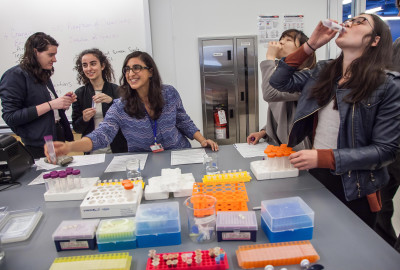The future of the New School’s growing science program and its recently opened lab spaces at the University Center faces a turning point after three years of development, said Katayoun Chamany, the associate professor of natural sciences and mathematics, who is charged with leading the program.
Frustrations regarding a tight budget and small staff has increased within the science programs as Chamany prepares for her sabbatical.
“I am leaving in four weeks and I don’t know what the game plan is,” Chamany said in an interview, where she expressed her frustration over the University’s lack of direction for the new labs.
The game plan, according to Chamany, was to add more personnel to the University Labs (meaning a lab manager and student technicians) by this current semester, but lack of administrative cooperation has led to none of these goals being met.
“What they say is until [the University Labs] are full,” Chamany continued, “We can’t invest in lab personnel.”
The occupancy rate of each lab space is reported to senior leadership and the more students in each class the more likely there is to be a concrete financial investment from the University
The Science Labs at the University’s three laboratories may not be familiar to those outside of the Interdisciplinary Science minor and major, but they’re actually housed in two locations. The first first being the original lab at 65 W. 11th St which can hold up to 24 students. The two recently opened labs are on the 6th floor of the 65 Fifth Avenue University Center; each can hold about 14 students (please check this as I had 25 students in 618 the other day). in each classroom.
In an attempt to appease the science programs needs, Marcus Banks was hired as a part-time lab technician. “We are a bit understaffed,” Banks wrote in an email, “We do have administrative and managerial needs which are not being met because we do not have enough full time staff.”
“The facilities here can go days or weeks without a science class having a lab in them,” Banks added, “It’s unfortunate. Science students should be using these spaces.”
More lab personnel for the new spaces would mean professors like Chamany could return to teaching classes and not acting as interim positions like lab manager or head of curriculum development.
Banks also expressed a need for more interdisciplinary collaboration within the sciences. He said this could lead to more design ideas like the amoeba shoe and plastic eating bacteria, concepts that are both sustainable and related to climate action. Banks ended with, “We can do that here.”

Meanwhile, other potential users of the space have appeared. While it could be assumed that the University labs are only for science students, that certainly did not stop Luciana Scrutchen and Julia Poteat, two fashion professors at Parson, from holding textiles and natural dyeing classes in the new spaces.
“It has been wonderful working in the labs,” Poteat said, “Our students have appreciated being able to experiment in such a well equipped space. We would very much like to hold classes in the labs going forward.”
Chamany was enthusiastic about this unlikely pairing, calling it “mind blowing experience,” but was concerned how collaborations like this could remain tenable with the University’s science program still at its first stages.
“The curriculum development is a pilot. The accounting and purchasing is a pilot. The equipment maintenance is a pilot,” Chamany said and proceeded to list how every aspect of the University Labs and its classes were still in their pilot phase.
Although the science programs seem to be moving at a snail’s pace, Banks, one of the few individuals manning the labs in Chamany’s absence, still has hope for students who’ve expressed their excitement at the recent University Lab open house.
“They love the space,” said Banks. “They love the ideas and they love the possibilities. They just don’t understand we can only make things happen if we have enough people fighting for it.”







